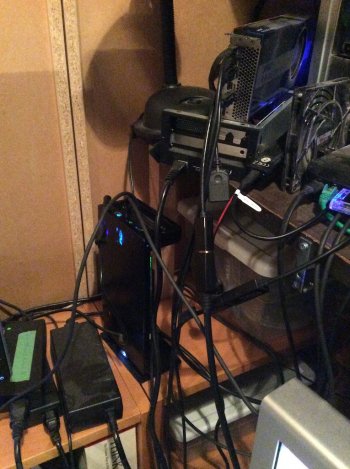I have used several Yottamaster and Orico external Thunderbolt 3 and one Thunderbolt 4 (plus USB-C) enclosures. On an Asus ExpertBook B9450 (Windows 10 up to and including 21H2) and on MacBook Pro 13 (2018, 4 Thunderbolt, Intel) as well as Mac Mini M1 (16GB, 1TB, 10 Gbit 2021) - the mac’s with the latest Big Sur.
Alle environments deliver results in the same region. APFS or ExtFAT on Macs and NTFS or ExtFAT on Windows. Diffrences are within very small margins, and with few percent across operating systems. The M1 is a good representative (drives directly connected):
Here Yottamaster with Samsung 970 Pro 1TB:
And my Orico Thunderbolt 3 (only) enclosure with similar Samsung 970 Pro 1TB:
The Samsung 970 Pro 1TB delivers similar performnce in all Thunderball enclosures, I have, and since it’s a MLC based SSD, the performance is constant irrespective of transfer size (no SLC cache used, full performance for complete copy to for all transfer data sizes).
Things become interesting with the CalDigit Elements Hub. No other traffic, and no Monitors connected, same Orico hardware and Samsung SSD:
The write speed falls roughly 30% on writes, while read speeds remains similar to direct connection (without any other activity in hub devices).
The CalDigit hub has a severe problem handling NvME USB drives (like the Sandisk Extreme Pro 1TB, old version), when connected to USB-A (with 10 Gbit cable). It’s probably a power problem, because the problem vanishes, when connected to USB-C (with 10 GBit cable).
All enclosures exhibit the same problems with Samsung 970 EVO PLus 2TB, irrespective of format and platform/OS. Read speeds are always “up there”, and write speeds hover in the region of 1100-1300 Mbyte/sec dpending on OS (formattging makes no real difference). It is essential, that Windows 10 caching is enabled (does not always happen by default), if you don’t want to end up around 800-900 Mbyte/sec write.
Special note on Big Sur on BOTH M1 and Intel Macs described above
The Asus ExpertBook B9450 (two easily accessible and active internal SSD sockets) was delivered with a Samsung MZVLB1T0HALR-00000 1TB SSD (often described as OEM PM981 etc), that delivers values in the region of Samsung EVO 970 or better. Especially sustained transfers are high, in the region of Samsung 970 EVO Plus.
I decided to mount my Samsung 970 EVO Plus 2TB inside instead. It just screams “performance”. Not quite 970 Pro on writes, alas… 970 Pro is not available in 2TB NvME sticks.
I mounted the Samsung MZVLB1T0HALR-00000 into the Orico Thunderboilt3/USB 4 enclosure, that had held the Samsung 970 EVO Plus 2TB, and reformatted the drive on Windows 10 (ExFAT) and performance was roughly identical to Samsung 970 EVO Plus in the enclosure. Write far lower than possible, but in the same region as the EVO Plus; that’s life.
The big surprise came, when I moved the drive to my MacBook (Intel). It dod not work, at all. Blackmagic Disk Sped Test froze after displaying 70MByte/sec read speed. Rpeat on M1 showed similar, but even lower speed before freezing up. Obviously something was horribly wrong. Maybe reformatting to APFS would help? No!
Big Sur showed the capacity to be 1.02 TB, and that was certainly not the case in real life, so the actual SSD was not to Big Sur’s taste (worked in Windows 10 in the same enclosure with the same cable).
There’s no wrong capacity handling in Windows 10, and both ExFAT and NTFS works as expected at the same speeds.
Conclusion
The short conclusion is, that enclosures behave similarly, when the same type SSD’s are used. Formattging has nigh to no influence on performance. Differences between macOS and Windows are very small, and likewise for differences between M1 and Intel based macs (if anything, Intel is less “problematic”). When USB ports are involved, M1 is generally around 30% slower, than the Intel platform for same drives and same transfer/contents. The slow-down is more or elss equal, whether 5GBit or 10GBit USB C/A gear is used.
Hope this will be of help to those experiencing problems.




